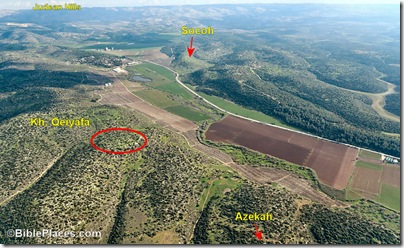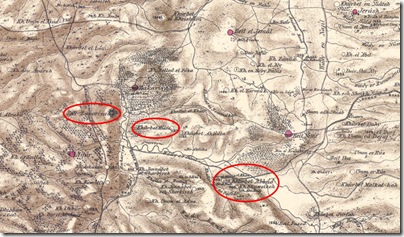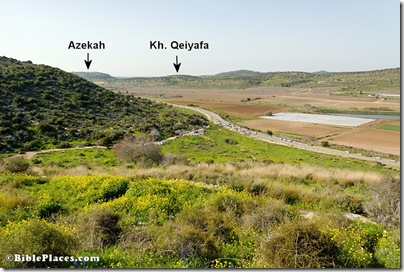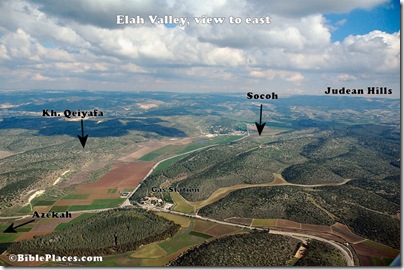If I were teaching a course in historical geography now to advanced students, I’d cancel one of the assignments and have them write a paper on the site identification of Khirbet Qeiyafa. They would be required to use all of the available data in suggesting possible candidates. Since I’m not teaching such a class, I can post my own thoughts here without fear of hindering their research.
It’s been a few weeks since I wrote about Kh. Qeiyafa, so a brief review is in order: Located next to the Elah Valley where David fought Goliath, Kh. Qeiyafa has been excavated the last two seasons (2007-08). This summer a 10th century B.C. inscription (ostracon) was discovered (photo), the contents of which have not yet been revealed, but may be very interesting.
The place to start in identifying Kh. Qeiyafa with a known historical place name is to look at the general area of the site. Kh. Qeiyafa is located on the north side of the Elah Valley, roughly north of probable Socoh (Kh. Abbad/Kh. es-Suweikeh) and east of probable Azekah (Tell Zakariyeh). Those last two identifications are generally agreed upon by scholars, but as far as I know there’s no certain proof of either identification (for a good discussion of Socoh and Azekah, see The Sacred Bridge, page 147). That’s important to keep in mind as we proceed under the assumption that Abbad = Socoh and Zakariyeh = Azekah.
Early explorers who identified sites like Hazor, Beth Shemesh, and Beth Shean did not have the advantage of aerial photographs and Google Earth. But since we have those at our disposal, we will put them to use.
You can locate Qeiyafa on Google Earth using this kmz file.
You can locate Qeiyafa on Google Maps with this link (via G. M. Grena)
You can see the site in relation to Socoh (Abbad) and the Elah Valley on the photo below.
Archaeology is critical in determining site identification, and Qeiyafa has remains dating to the early 10th century and to the Hellenistic period. To do a thorough job in my little exercise, one would need to investigate Hellenistic sources concerning sites given in this area. Because the occupation gap is so large (c. 800 years), it is possible that the Iron Age name was not preserved. Since I am less knowledgeable about Hellenistic sources, and don’t have the necessary time, I am going to ignore this part of the equation.
The textual sources that we have for this time period are limited. The Bible is the obvious place to start, though as I’ll note, some scholars question the traditional dates given to biblical texts. Another source is the ostracon previously discussed. It is possible that this ostracon has one or more place names and may single-handedly answer this question. (Well, not really single-handedly, as it has to be in agreement with the rest of the data, but its relative importance is potentially great.) Another possible source is Shishak’s conquest list as given on the Bubastite Portal in the Karnak Temple.
Since no other sites in the vicinity of the Elah Valley appear to be mentioned by Shishak, I am going to ignore that for now.
What can we learn from the Bible? It might be instructive to note first that many scholars these days would sneer at this question. It then would be worth reviewing just how many hundreds of accurate site identifications were made in the last 150 years, using the Bible as the primary source. That is how Edward Robinson did it, as well as many successors on down to Yohanan Aharoni and his students and “grandstudents” (among whom I count myself).
A good place to start is with the passage of the battle of David and Goliath, as this was situated in the Elah Valley. The setting is given in 1 Samuel 17:1:
Now the Philistines gathered their armies for battle. And they were gathered at Socoh, which belongs to Judah, and encamped between Socoh and Azekah, in Ephes-dammim (ESV).

Aerial view of Elah Valley, view to southeast
While the locations of Socoh and Azekah are generally agreed upon (see above), the location of Ephes-dammim is uncertain. Based on the above text, it seems that it is located “between” the two sites. “Pas Dammim” is mentioned in 1 Chronicles 11:13 and could well be the same place, though the event described there is a different one than the David and Goliath story. A parallel to 1 Chron 11:13 is given in 2 Samuel 23:9; the place name is lacking in the Masoretic Text but is given as “Pas Dammim” in the Septuagint. These are the only references to Ephes/Pas Dammim in the Bible.
In teaching the David and Goliath story, I’ve pointed to the “gas station” (labeled on the first photo above) as a possible place for Ephes-dammim. There’s no evidence for this, but since no other site has been identified and this sits neatly between Azekah and Socoh on the southern ridge of the valley, it was a convenient marker.
But now a new possibility arises: Could Khirbet Qeiyafa be Ephes-dammim? There are three points in favor of this identification:
1) Like Ephes-dammim (ED), Qeiyafa is “between” Azekah and Socoh;
2) Like ED, Qeiyafa was inhabited in the 10th century;
3) Since the only textual references to ED are in the 10th century, and Qeiyafa was inhabited only in the 10th century (during the time of the Bible), this too would match. [Note: the biblical chronology seems to put the David/Goliath battle in the late 11th century, but the difference is only a few decades here and archaeology is usually not able to be very precise, especially at this period of time.]
 Kiafa (Qeiyafa) is clearly between Azekah and Socoh; map from Survey of Western Palestine (1870s)
Kiafa (Qeiyafa) is clearly between Azekah and Socoh; map from Survey of Western Palestine (1870s)
Some have suggested that the modern site of Damun preserves the name of Ephes-dammim, but as Steven Ortiz notes in the Eerdman’s Dictionary of the Bible (p. 411), Damum is 4 miles (6.5 km) northeast of Socoh when one would expect it to be west (and east of Azekah).
Another possible text that lists cities from the 10th century (though many scholars think it dates to much later) is the list of Rehoboam’s fortifications (2 Chronicles 11:5-10): “Rehoboam lived in Jerusalem and built up towns for defense in Judah: Bethlehem, Etam, Tekoa, Beth Zur, Soco, Adullam, Gath, Mareshah, Ziph, Adoraim, Lachish, Azekah, Zorah, Aijalon and Hebron.” The location of nearly all of these sites is pretty well agreed on, not suggesting another possibility for Qeiyafa.
A text that many scholars would go to for sites is the city list of Judah from Joshua 15. Clearly this is the best geographical list for the area, but I didn’t start there because I believe (hold your breath) that this list dates hundreds of years earlier than the 10th century. Most scholars do not, and accordingly, I will not ignore it. Joshua 15:33-36 lists cities of Judah: “In the western foothills: Eshtaol, Zorah, Ashnah, Zanoah, En Gannim, Tappuah, Enam, Jarmuth, Adullam, Socoh, Azekah, Shaaraim, Adithaim and Gederah (or Gederothaim)—fourteen towns and their villages.” The location of many of these cities is not positively identified. Based on the sites whose identification is generally agreed on (Eshtaol, Zorah, Jarmuth, Adullam, Socoh, Azekah), the list seems to proceed from north to south. The Elah Valley sites are all known (Adullam, Socoh, Azekah), and do not give us an extra name to associate with Qeiyafa, particularly between Socoh and Azekah as we might expect from 1 Sam 17:1. If Joshua 15 is a pre-10th century text, then this is not surprising.
The “prophet of the Shephelah” is Micah, who lived in the late 8th century. His hometown is given as Moresheth (probably known elsewhere as Moresheth-gath) in Micah 1:1. He pronounces judgment on many cities in the Shephelah from 1:10-16, a number of which are unknown (particularly in vv. 11-12). Too little is stated to pin down locations for these (Beth Ophrah, Shaphir, Zaanan, Beth Ezel, Maroth), but none is mentioned in connection with Adullam, a city on the eastern end of the Elah valley. Again, I wouldn’t expect to find a relevant name here since Qeiyafa was apparently abandoned several hundred years earlier.
 View from Socoh looking west towards Azekah
View from Socoh looking west towards Azekah
Are there other possibilities? A quick check of Ahituv’s Canaanite Toponyms in Ancient Egyptian Documents, Tabula Imperii Romani, and Eusebius’s Onomasticon do not seem to suggest any other potential site names.
Was Kh. Qeiyafa a Philistine outpost? This summer the excavations discovered a four-chambered
city gate and a 13-foot-wide (4 m) casemate wall. (Photos of excavations here and a 4-minute video of mostly still photos here.) It certainly was a stronghold, and the only two known powers of the region at this time were the Philistines and the Israelites. The Egyptians were back home enjoying their Third Intermediate Period, and there does not seem to be any strong contingent of Canaanites in the Shephelah (those would have likely migrated to where there were fewer enemies, such as the Jezreel Valley).
We can speculate further. Perhaps Kh. Qeiyafa was Ephes-dammim, and it was constructed by the Israelites in the 11th century as they competed with Philistia for the Shephelah. But one day the Philistines succeeded in capturing the fortress. That brought Saul and the Israelites down to battle to regain their stronghold. That could explain the otherwise curious reference in 1 Sam 17:1 to Ephes-dammim, as well as to giving its specific coordinates (since it was not well-known, then or later).
Unfortunately for the Israelites, Goliath wanted to make the battle a contest of champions and there was no one brave enough among the Israelites to respond. The Israelites were encamped opposite the Philistines on the south side of the valley (which is the opposite of how I have always pictured it), or possibly in the hill country to the east. David’s victory sent the Philistines fleeing towards Gath and Ekron (1 Sam 17:52), which makes perfect sense given the location of Kh. Qeiyafa.
While the above paragraph is speculative, the data that connects Qeiyafa with Ephes-dammim seems to me to be stronger than that which exists for many biblical sites. The biblical text is very specific, and Qeiyafa matches exactly. The dating of the fortress to the early 10th century is very close as well. It’s certainly intriguing to consider. Perhaps the ostracon discovered this summer will help to relate Kh. Qeiyafa to the biblical narrative, or even to confirm/deny the possibility that the site is biblical Ephes-dammim. We’ll be interested to learn more when details are released.

17 thoughts on “The Identity of Khirbet Qeiyafa”
"The Israelites were encamped opposite the Philistines on the south side of the valley (which is the opposite of how I have always pictured it), or possibly in the hill country to the east."
Todd, I just went to Israel this summer and we went to this site. Are you saying that where David & Goliath fought was closer to Khirbet Qeiyafa away from where the tour buses drop you off? The buses dropped us off closer to Azekah.
Using the photos for reference:
I assume your tour bus stopped where the first “a” of Azekah is on the top photo.
If KQ is ED, then the Israelites may have been encamped south of the valley. That would put them on the ridge next to Socoh in the second photo.
Alternately, the Israelites may have been east of KQ/ED, that is on the slopes below the “Judean hills” label, also on the second photo.
thanks for your analysis, todd. i’ve been following those excavations with interest. I think there’s quite a bit of good work going on at the moment to find out more about the interaction between the philistines and Israel / Judah and the dynamics of the border.
Someone should give you a doctorate already, Todd! Thanks! Very interesting and rather exciting!
Sounds reasonable.
I don’t suppose there are any other settlements in the immediate area that are unidentified?
I do see one potential problem: 1 Sam 17:1 says that the Philistines *camped* at Ephes-Dammim – which would be an odd description if they were in fact lodging at a fortified city.
I suppose it could mean that they were camped *against* Ephes-Dammim – the preposition “b” would tolerate either “camp at” or “camp against [for war]”- see Judges 9:50 for the latter. So this would mean that the town belonged to Judah at the time and the Philistines were trying to take it. If you look at it this way, Saul’s troops were reinforcements for his beseiged city.
Peripheral question: why would the Philistines muster at Socoh “which belongs to Judah”?
Ah, and something else: if Ephes Dammim is Qeiyafa, and the Philistines had control of the site during the David-Goliath battle (as you say), then their running straight to Philistia upon Goliath’s defeat doesn’t make sense – they would have retreated straight into the fortified town right behind them. The fact that they fled shows that they had no stronghold there. I think this point would also support an Israelite occupancy of ED/Qeiyafa at the time.
In any case, the pottery from Qeiyafa should show ethnicity without too much trouble. Based on the above points, I’ll wager a dollar fifty it’s Israelite.
Darn you Bolen, now you’ve got me wanting to buy Sacred Bridge.
Socoh seems like a better spot for the Israelite camp to me. While it is one of the smaller hills, it is highly defensible, with no gentle slops to attack up. It also gives them an escape route to the east if over run. I know that access to water would have been a problem, but it would have been on any hill.
Until I thought about that, I wondered why anyone would pick this smaller, lower hill to camp on. Even men with iron weapons would take a major beating trying to attack up that slope. This could be why the seemingly superior Philistine army didn’t just end things with a frontal assault.
Guess we just wait until the ostracon is released.
Almost certainly there are other unidentified sites in the area; the Shephelah is full of settlements. I'd have to check the Shephelah survey (and I don't have time this month).
An important issue that you raise concerns the size of KQ. Based on photographs, my assumption has been that the fortified area was rather small (thus a "fort" rather than a walled city). According to the excavator's report last year, the site is 35 acres, which is larger than Lachish! But I'm not sure how much of that was fortified (or even occupied in the 10th century). That report is here:
http://www.israntique.org.il/article_Item_eng.asp?sec_id=17&subj_id=487&id=1332&module_id=#as
If KQ was a fort at the time of David and Goliath, it makes good sense that the army would camp there, as 1) they couldn't fit inside a small fort and wouldn't need the protection of the walls anyway and 2) their "camp" has a name (ED).
It's possible that the Philistines were trying to take ED at the time of the battle of David and Goliath, but I think this would be clearer in the text if so.
As for determining ethnicity, one problem could be if the fortress was held by both forces at different times (and thus pottery from both peoples was found there).
I think the reference to Socoh in Judah is simply the biblical (Israelite) writer saying that this city belonged to Judah. The fact that Philistines were at an Israelite city makes the conflict clear from the start.
If KQ was an Israelite stronghold at the time of the battle of David and Goliath, then KQ is not ED. Rather one should look for ED on the other side of the valley. At the moment I can’t think of any compelling evidence against this possibility, except that we have one known fortified site between Azekah and Socoh and one given place name in the Bible.
One other note: the IAA report linked to above mentions a LMLK seal (8th c.). Reports on the Elah Fortress website mention that the site was inhabited only in the early 10th century and not later in the Iron Age. I’m not sure how that fits in, unless Hezekiah’s men later “camped” there. Of course with preliminary reports such as are available, everything is subject to change with further analysis in the lab and excavations on the field.
I don't have anything to add to this tremendously well-written article, Todd (& the photos are spectacular of course), but just wanted to thank you for emphasizing the importance of the excavation there. You really have a fantastic way of highlighting what's important about all these Bible places. It never occurred to me before now, but you sure would make a terrific senior editor for BAR some day.
Todd,
Great article. It’s well thought out.
I don’t see the reference to “pas dammim” in the LXX of 2 Sam 23:9. I only glanced at the LXX in Bible Works (which is Rahlf’s edition with no apparatus, and not the Goettingen edition), so perhaps it appears in one of the recensions (i.e. Aq., Symm, Theod)?
Danny, I’m not sure the verb “to camp” should give us too much trouble. Yes, it often means “to camp” in the nomadic sense, but when we consider that Isa 29:1 says that Ariel was the city (Heb. kiriyah) that David “camped” in, then I think it would be possible for the writer to say that the Philistines “camped, took up residence, lodged, etc.” in the fortified city of Ephes Dammim (assuming, of course, that Todd is correct in identifying it with Qeiyafa).
Benj F.
Benj – Pas Dammim is in the Lucianic manuscripts of the LXX.
Great post Todd, love the historical geography. Just a few things to note. First it seems that the Hebrew word for camp or encampments refers to impermanence and not a specific type of settlement (ie. tent, fort, whatever), so this would indicate that the Philistines were there temporarily. This definitely allows for a possible Israelite fort (built as they expanded through the Elah valley) that was taken over by the Philistines as they attempted to gain access to the hill country by way of the route through Bethlehem.
Second I believe this id makes sense as Saul and the Israelites would have not ventured out of the hill country and across the Chalk Moat (acting as a geographical border between shephelah and hill country) to set up camp because that would have exposed them in case of retreat. So the Philistines would have moved from Asekah to Ephes-Dammim to Socoh, in order to confront the Israelites who would have been camped at the edge of the hills (perhaps where a moshav is located today). Oh and I have an article being published in the upcoming NEASB on the date of the Judah City List (Joshua 15) and the historical geography of the Chalk Moat.
This is fun stuff to think through; I’ve never actually thought of the exact objective of the Philistine campaign (i.e., what town they were trying to take) – distracted by the David/Goliath drama, I suppose. Another couple of comments/responses:
“If KQ was a fort at the time of David and Goliath, it makes good sense that the army would camp there, as 1) they couldn’t fit inside a small fort and wouldn’t need the protection of the walls anyway and 2) their “camp” has a name (ED).”
1) Maybe they didn’t need to camp outside the walls. On the size of KQ: the Wikipedia entry lists the upper city as about 3 hectares, which looks consistent with the walls visible on Google maps. That’s about two and a half football fields. Probably enough space for a decent sized army contingent. And as Benj points out, it’s possible that they “camped” in a town (thanks Benj for the reference – with an exotic construct-to-finite-verb construction, no less). So it’s possible that the Philistines camped in or against Ephes Dammim. (BTW, I think “ED” is an unfortunate acronym. You might want to avoid it.)
2) You’re right that the name Ephes Dammim is important. If there are no other settlements on the hillsides between Socoh and Azekah, then you’re probably right in your site identification.
On the reference to Socoh in 1 Sam 17:1: “The fact that Philistines were at an Israelite city makes the conflict clear from the start.”
If you’re saying what I think you’re saying, then I agree that this is possible. =) After thinking a bit more about it, I think the reference to “Socoh which belonged to Judah” would support a reconstruction wherein the Philistines are “camped” in/at Ephes Dammim, but they “gathered” – i.e., they sortied – to Socoh to try and take it from Judah. (Is this what you meant above? Is this the normal interpretation of this passage? I haven’t looked at any commentaries or anything, so I don’t know) If this *isn’t* what the text means, then that reference to Socoh in this verse is a bit awkward (and why I questioned it before).
So if this last point swings the ambiguity of the Ephes Dammim reference (that the Philistines camped either “in” or “against” it) towards your interpretation (Todd), then I guess that just leaves one point of awkwardness (for me): that the Philistines were so unnerved when Goliath was killed that they abandoned their perfectly defensible fortress with massive, megalithic walls. Hysteria?
I did a quick check in Accordance and it appears that ב + חנה does not mean “besiege,” but to “camp at/in.”
Josh 10:31 talks of besieging and uses the preposition על.
Okay, the fancy Hebrew stuff didn’t work right.
That should be חנה followed by ב, not the other way around.
dfrese – with regard to your last point, that it makes no sense for the Philistines to flee a fortified position, a couple of thoughts. 1) Remember that the competition was framed as a “contest of champions” and with Goliath’s defeat, the Philistines should have surrendered (v. 9). Maybe at that point, every man was concerned only for himself and to get as far away from potential servitude in Israel as possible. 2) If the Philistines had previously taken Ephes-dammim from Israel, then David’s victory may have at least suggested that Israel get the fortress back (or that the Israelites would be strong enough to take it back). Ultimately, I’m not sure that rational thought was necessarily fully operative after seeing the head of their champion uplifted.
Sorry about the acronym. I suppose if I watched more TV commercials I would be sensitive to things like that.
>Remember that the competition was framed as a "contest of champions" and with Goliath's defeat, the Philistines should have surrendered.
>>>>>>>>>>>>>>>>>>>>>>>>>>>>>
I suspect there were very few times this kind of contest was agreed to, but even fewer when the losing side actually gave up. There were no umpires back then.
I suspect it was a conbination of things that caused them to run.
1. As you said, seeing the guy you hoped to follow behind in the battle line lose his head was a major factor.
2. There was always the "whose god is stronger" element to battle, and if a kid could kill Goliath, then maybe his God was at least "the god of this place".
3. It must have also been a shock to realize that the iron armour they relied on to protect them could be overcome simply with a sling and a rock. David was probably not the only slinger in the Israelite army and they must have felt more vunerable after watching Goliath go down with a single stone.